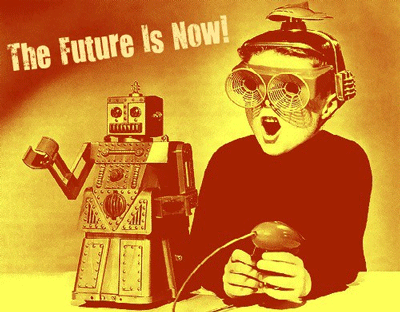Our chief strategy officer explains that there are two futures. You don’t have to wait for AI, self-driving cars, and smart glasses to see how much is going to change.
_______________________________________________________________________________________
By Brad Berens
The digital revolution is just getting started: more changes to more facets of our everyday lives are coming. In the same way that it would be challenging for us to explain life in 2018 to somebody in 1968 (what — no phone booths?) my kids’ kids will look back on our lives today as if we were medieval.
 Big changes are coming, and it’s easy to let the coming, huge, things-will-never-be-the-same-again developments distract us from new technologies and services that have already shown up to change life as we know it.
Big changes are coming, and it’s easy to let the coming, huge, things-will-never-be-the-same-again developments distract us from new technologies and services that have already shown up to change life as we know it.
There are two futures.
The first is the big vision of the future, which involves things like driverless cars, pervasive sensors around us and inside us, artificial intelligences running the boring parts of our lives, drones delivering lattes, and smart glasses that let us inhabit new worlds or edit the world we’re standing in.
But while we’re impatiently tapping our feet waiting for the big vision to come into focus, it’s important to see the changes that are already happening– that’s the second future.
Back in 1993, science fiction novelist William Gibson captured what I’m talking about succinctly: “The future is already here: it’s just not very evenly distributed.”
Driverless cars are a case in point. A week does not go by without news and magazine articles detailing technological progress on reaching the holy grail of Level Five autonomous driving (when we’ll always be able to play with our phones instead of concentrating on traffic), scientific and regulatory setbacks, and tragic fatalities.
Car manufacturers worry — appropriately — that driverless cars will have asteroid-impacting-the-Earth consequences for their businesses. This is why, for example, former Ford CEO Mark Fields started describing Ford as a “mobility company” rather than a car company, and also why, when Ford fired Fields, it replaced him with Jim Hackett, the person who had been running the company’s Smart Mobility innovation unit.
It’s impossible to overstate the transformative impact that driverless cars will have on many more industries than just transportation, as Center founder Jeffrey Cole described in his column from last summer, “How driverless cars change everything.”
But driverless cars are still a few years out: what about the future that’s already here?
In our Future of Transportation project, when we asked Americans if they’d give up owning or leasing their own cars, 80 percent said no, which is 20 percent consideration. However, when we zoomed in on the relatively small slice of the population who use what we call Get-a-Ride Services (GARS) like Uber, Lyft, Car2Go or Zipcar, that 20 percent consideration doubled to 40 percent.
What this means is that car ownership in this country has already peaked: it will only get smaller because for the first time in over a century having a car is no longer the default presumption for anybody who lives outside of dense urban centers with lots of public transportation. In other words, not owning a car is now thinkable. (This does not, however, mean that I think Uber will survive as a company, as I’ve argued elsewhere.)
_________________________________________________________________________________________________
The big vision of the future involves things like driverless cars, pervasive sensors around us and inside us, artificial intelligences running the boring parts of our lives, drones delivering lattes, and smart glasses that let us inhabit new worlds or edit the world we’re standing in. But while we’re impatiently tapping our feet waiting for the big vision to come into focus, it’s important to see the changes that are already happening– that’s the second future.
_________________________________________________________________________________________________
Beyond just getting around, some of the big tectonic changes to other industries are already happening: we don’t have to wait for self-driving cars.
For instance, Santa Monica, California-based Freebird Rides works with bar owners to remove the cost and hassle of transportation from coming to the bar. If, for example, Murphy’s Pub reliably has a slow Tuesday night, then Murphy can set a predetermined budget with Freebird to encourage customers to come in on Tuesday with a free Uber ride.
This has two remarkable consequences.
First, generally the person getting the free ride brings at least one friend, so for the cost of a $10 Uber ride Murphy gets two or three patrons who are going to spend a lot more than $10 each.
Second, and more importantly, by working with Freebird, Murphy simultaneously encourages increased consumption of alcohol while decreasing drunk driving because the Freebird-driven patrons left their cars at home.
The implications are enormous because other industries can similarly benefit by factoring transportation into the cost of doing business. Restaurants, concert venues, theaters, even the local multiplex, can partially de-risk a night out by removing the hassle of driving and parking. Shopping malls might find new vigor if customers could get free rides there and home again later.
Transportation is just one example of the future that’s already here. The numberless articles about the coming AI revolution — the big vision of the future — can distract us from thinking about how there is already a digital assistant in every iPhone and Android phone on the planet, an install base far greater than that of smart speakers. Worries about drone surveillance can distract us from reckoning with how creepy it is that Alexa may already be recording our conversations and sharing those recordings with other people.
If you want to see the future, just look around.
__________

Brad Berens is the Center’s Chief Strategy Officer.
See all columns from the Center.
May 30, 2018

